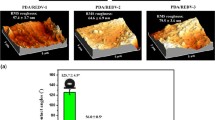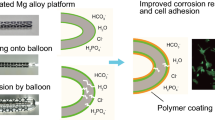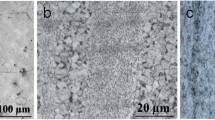Abstract
Magnesium alloy has been generally accepted as an important biodegradable material on cardiovascular stent development for a long time. However, its limited biocompatibility, especially delayed endothelialization process restricts its further application. In this contribution, we modified the Mg-Zn-Y-Nd alloy surface with citric acid and dopamine via a layer-by-layer self-assembly assay, aiming at improving the biocompatibility of the magnesium alloy. The citric acid/dopamine (CA/PDA) layer exhibited a remarkable suppression of platelet activation/aggregation and thrombosis under 15 dyn/cm2 blood flowing. Inhibition on vascular smooth muscle cells growth and macrophages attachment/activation were also observed on this layer. In particular, the CA/PDA layer presented a promoted property for the vascular endothelial cells growth and spreading compared with the bare magnesium alloy, suggesting the pro-endotelialized function. In conclusion, this research may support potential application on surface modification of magnesium alloy based cardiovascular stents for better biocompatibility.
Similar content being viewed by others
References
World Health Organization (WHO). Global status report on noncommunicable diseases 2014. Geneva, 2014
Fuster V. Top 10 cardiovascular therapies and interventions for the next decade. Nat Rev Cardiol, 2014, 11: 671–683
Serruys P W, Kutryk M J B, Ong A T L. Coronary-artery stents. N Engl J Med, 2006, 354: 483–495
Ramcharitar S, Serruys P W. Fully biodegradable coronary stents. Am J Cardiovasc Drug, 2008, 8: 305–314
Moravej M, Mantovani D. Biodegradable metals for cardiovascular stent application: Interests and new opportunities. Int J Mol Sci, 2011, 12: 4250–4270
Yang H, Wang C, Liu C, et al. Evolution of the degradation mechanism of pure zinc stent in the one-year study of rabbit abdominal aorta model. Biomaterials, 2017, 145: 92–105
Erbel R, Di Mario C, Bartunek J, et al. Temporary scaffolding of coronary arteries with bioabsorbable magnesium stents: A prospective, non-randomised multicentre trial. Lancet, 2007, 369: 1869–1875
Liu J, Wang P, Chu C C, et al. Arginine-leucine based poly (ester urea urethane) coating for Mg-Zn-Y-Nd alloy in cardiovascular stent applications. Colloids Surf B, 2017, 159: 78–88
Liu J, Xi T. Enhanced anti-corrosion ability and biocompatibility of PLGA coatings on MgZnYNd alloy by BTSE-APTES pre-treatment for cardiovascular stent. J Mater Sci Tech, 2016, 32: 845–857
Wu Q, Zhu S, Wang L, et al. The microstructure and properties of cyclic extrusion compression treated Mg-Zn-Y-Nd alloy for vascular stent application. J Mech Behav Biomed Mater, 2012, 8: 1–7
Zhu S J, Liu Q, Qian Y F, et al. Effect of different processings on mechanical property and corrosion behavior in simulated body fluid of Mg-Zn-Y-Nd alloy for cardiovascular stent application. Front Mater Sci, 2014, 8: 256–263
Zhang K, Li J A, Deng K, et al. The endothelialization and hemocompatibility of the functional multilayer on titanium surface constructed with type IV collagen and heparin. Colloids Surf B, 2013, 108: 295–304
Li J, Zhang K, Chen H, et al. A novel coating of type IV collagen and hyaluronic acid on stent material-titanium for promoting smooth muscle cell contractile phenotype. Mater Sci Eng-C, 2014, 38: 235–243
Li J, Yang P, Zhang K, et al. Preparation of SiO2/TiO2 and TiO2/TiO2 micropattern and their effects on platelet adhesion and endothelial cell regulation. Nucl Instrum Methods Phys Res Sect B, 2013, 307: 575–579
Frattolin J, Barua R, Aydin H, et al. Development of a novel biodegradable metallic stent based on microgalvanic effect. Ann Biomed Eng, 2016, 44: 404–418
von Birgelen C, Kok M M, van der Heijden L C, et al. Very thin strut biodegradable polymer everolimus-eluting and sirolimus-eluting stents versus durable polymer zotarolimus-eluting stents in allcomers with coronary artery disease (BIO-RESORT): A three-arm, randomised, non-inferiority trial. Lancet, 2016, 388: 2607–2617
Cao F, Song G L, Atrens A. Corrosion and passivation of magnesium alloys. Corrosion Sci, 2016, 111: 835–845
Liu P, Pan X, Yang W, et al. Improved anticorrosion of magnesium alloy via layer-by-layer self-assembly technique combined with micro- arc oxidation. Mater Lett, 2012, 75: 118–121
Simonte F M, Dötsch A, Galego L, et al. Investigation on the anaerobic propionate degradation by Escherichia coli K12. Mol Microbiol, 2017, 103: 55–66
Ye M, Zhang L, Xu P, et al. Simultaneous analysis of ten low-molecular-mass organic acids in the tricarboxylic acid cycle and photorespiration pathway in Thalassiosira pseudonana at different growth stages. J Sep Sci, 2017, 40: 635–645
Martin M, Perez-Guaita D, Andrew D W, et al. The effect of common anticoagulants in detection and quantification of malaria parasitemia in human red blood cells by ATR-FTIR spectroscopy. Analyst, 2017, 142: 1192–1199
Lee H, Dellatore S M, Miller W M, et al. Mussel-inspired surface chemistry for multifunctional coatings. Science, 2007, 318: 426–430
Lee H, Lee B P, Messersmith P B. A reversible wet/dry adhesive inspired by mussels and geckos. Nature, 2007, 448: 338–341
Wu F, Li J, Zhang K, et al. Multifunctional coating based on hyaluronic acid and dopamine conjugate for potential application on surface modification of cardiovascular implanted devices. ACS Appl Mater Interfaces, 2016, 8: 109–121
Li J A, Zhang K, Xu Y, et al. A novel co-culture models of human vascular endothelial cells and smooth muscle cells by hyaluronic acid micro-pattern on titanium surface. J Biomed Mater Res A, 2014, 102A: 1950–1960
Li J, Li G, Zhang K, et al. Co-culture of vascular endothelial cells and smooth muscle cells by hyaluronic acid micro-pattern on titanium surface. Appl Surf Sci, 2013, 273: 24–31
Li J, Wu F, Zhang K, et al. Controlling molecular weight of hyaluronic acid conjugated on amine-rich surface: Toward better multifunctional biomaterials for cardiovascular implants. ACS Appl Mater Interfaces, 2017, 9: 30343–30358
Zhang K, Bai Y, Wang X, et al. Surface modification of esophageal stent materials by a polyethylenimine layer aiming at anti-cancer function. J Mater Sci-Mater Med, 2017, 28: 125
Kokubo T, Takadama H. How useful is SBF in predicting in vivo bone bioactivity? Biomaterials, 2006, 27: 2907–2915
Feng Y, Zhu S, Wang L, et al. Characterization and corrosion property of nano-rod-like HA on fluoride coating supported on Mg-Zn-Ca alloy. Bioact Mater, 2017, 2: 63–70
Li J, Zhang K, Yang P, et al. Human vascular endothelial cell morphology and functional cytokine secretion influenced by different size of HA micro-pattern on titanium substrate. Colloids Surfs B-Biointerfaces, 2013, 110: 199–207
Xiang L, Li J, He Z, et al. Design and construction of TiO2 nanotubes in microarray using two-step anodic oxidation for application of cardiovascular implanted devices. Micro Nano Lett, 2015, 10: 287–291
Wu J, Li J, Wu F, et al. Effect of micropatterned TiO2 nanotubes thin film on the deposition of endothelial extracellular matrix: For the purpose of enhancing surface biocompatibility. Biointerphases, 2015, 10: 04A302
Li J, Zhang K, Wu J, et al. Co-culture of endothelial cells and patterned smooth muscle cells on titanium: Construction with high density of endothelial cells and low density of smooth muscle cells. Biochem Biophys Res Commun, 2015, 456: 555–561
Li J, Zhang K, Yang P, et al. Research of smooth muscle cells response to fluid flow shear stress by hyaluronic acid micro-pattern on a titanium surface. Exp Cell Res, 2013, 319: 2663–2672
Li L, Xu Y, Zhou Z, et al. The effects of Cu-doped TiO2 thin films on hyperplasia, inflammation and bacteria infection. Appl Sci, 2015, 5: 1016–1032
Li J, Zhang K, Wu J, et al. Tailoring of the titanium surface by preparing cardiovascular endothelial extracellular matrix layer on the hyaluronic acid micro-pattern for improving biocompatibility. Colloids Surf B, 2015, 128: 201–210
Zhou Z, Chen J, Xiang L, et al. Fabrication of 3D TiO2 micromesh on silicon surface and its effects on platelet adhesion. Mater Lett, 2014, 132: 149–152
Li J, Zou D, Zhang K, et al. Strong multi-functions based on conjugating chondroitin sulfate onto an amine-rich surface will direct the vascular cell fate for cardiovascular implanted devices. J Mater Chem B, 2017, 5: 8299–8313
Manakhov A, Kedroňová E, Medalová J, et al. Carboxyl-anhydride and amine plasma coating of PCL nanofibers to improve their bioactivity. Mater Des, 2017, 132: 257–265
Zhang E, Shen F. Blood compatibility of a ferulic acid (FA)-eluting PHBHHx system for biodegradable magnesium stent application. Mater Sci Eng-C, 2015, 52: 37–45
Liu X, Zhen Z, Liu J, et al. Multifunctional MgF2/polydopamine coating on mg alloy for vascular stent application. J Mater Sci Tech, 2015, 31: 733–743
Wang F, Li C, Ding F H, et al. Increased serum TREM-1 level is associated with in-stent restenosis, and activation of TREM-1 promotes inflammation, proliferation and migration in vascular smooth muscle cells. Atherosclerosis, 2017, 267: 10–18
Kim J H, Bae K H, Byun J K, et al. Lactate dehydrogenase-A is indispensable for vascular smooth muscle cell proliferation and migration. Biochem Biophys Res Commun, 2017, 492: 41–47
Wen H, Liu M, Liu Z, et al. PEDF improves atherosclerotic plaque stability by inhibiting macrophage inflammation response. Int J Cardiol, 2017, 235: 37–41
Liu J, Zheng B, Wang P, et al. Enhanced in vitro and in vivo performance of Mg-Zn-Y-Nd alloy achieved with APTES pretreatment for drug-eluting vascular stent application. ACS Appl Mater Interfaces, 2016, 8: 17842–17858
Singh P, Kaur S, Sharma A, et al. TNF-α and IL-6 inhibitors: Conjugates of N-substituted indole and aminophenylmorpholin-3-one as anti-inflammatory agents. Eur J Med Chem, 2017, 140: 92–103
Author information
Authors and Affiliations
Corresponding authors
Rights and permissions
About this article
Cite this article
Chen, L., Li, J., Chang, J. et al. Mg-Zn-Y-Nd coated with citric acid and dopamine by layer-by-layer self-assembly to improve surface biocompatibility. Sci. China Technol. Sci. 61, 1228–1237 (2018). https://doi.org/10.1007/s11431-017-9190-2
Received:
Accepted:
Published:
Issue Date:
DOI: https://doi.org/10.1007/s11431-017-9190-2




